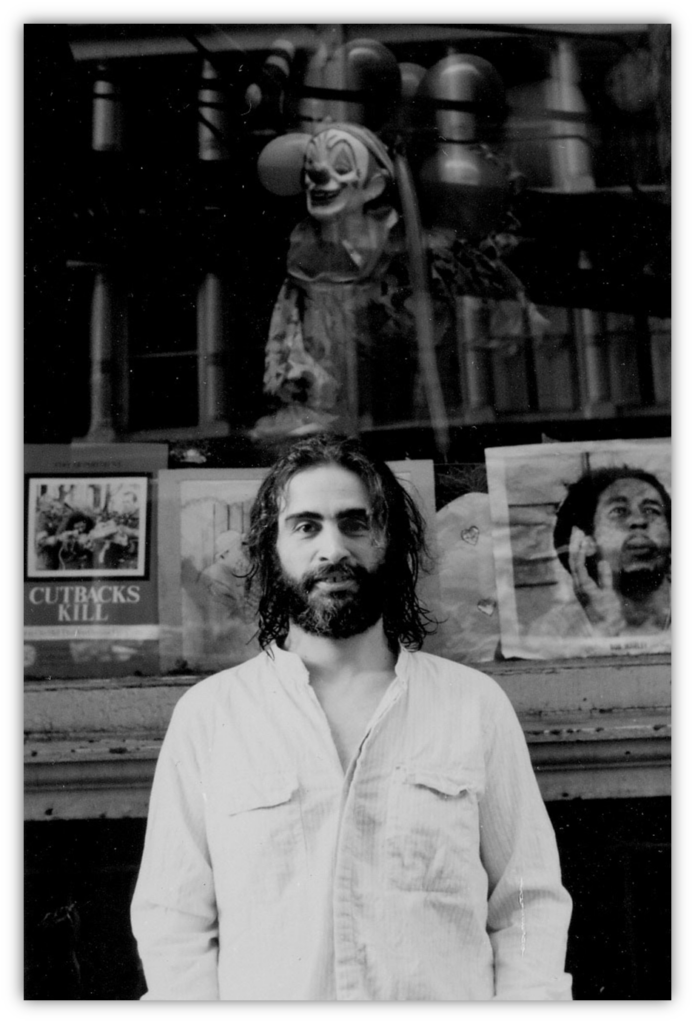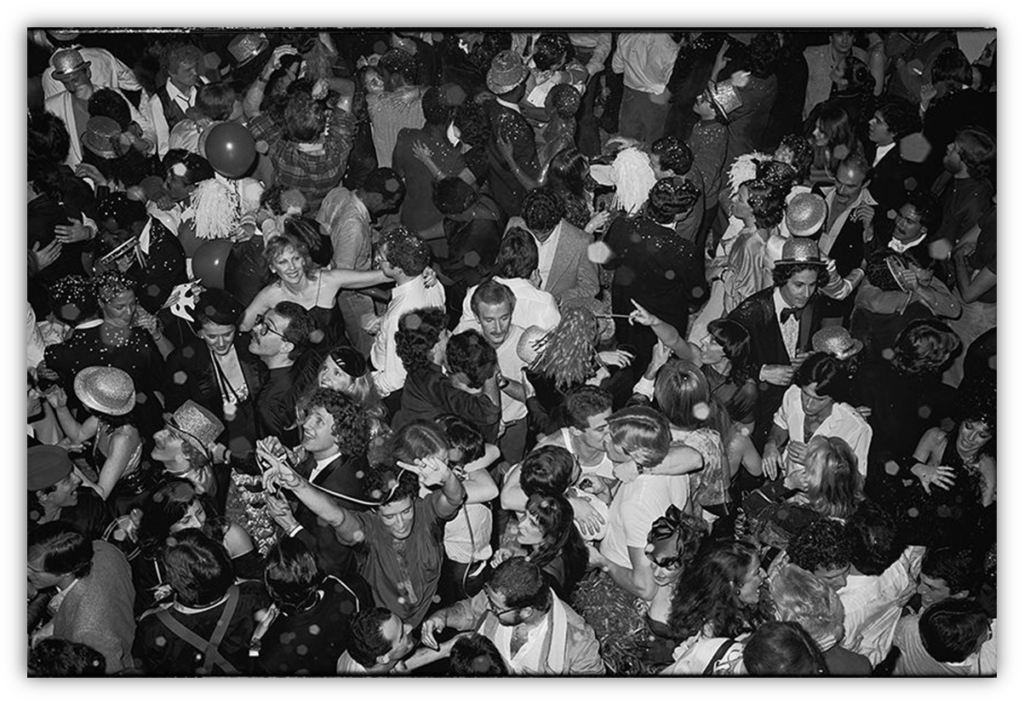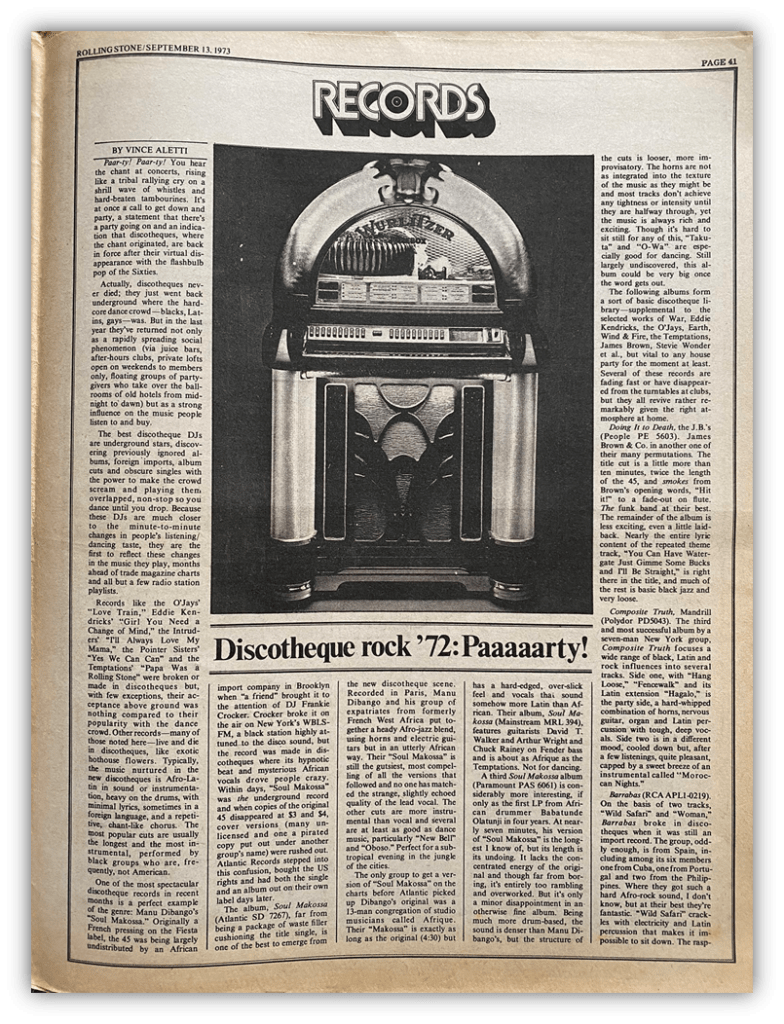Bill Bois’ Music Theory For Non-Musicians™
…if there was ever an art where breaking the rules is one of the rules, it’s music.
redditor u/COMPRIMENS
S3:E5 – What Makes Disco Disco ? Part 1
If I called all my friends, invited them over for a party, and told them there would be a cover charge at the door, it would be a very dull party.
Just me and the cat. And the cat isn’t a great dancer.

I’m not the one still working on my “Mad Lambada Skills” in 2022.
But it worked for David Mancuso.

He threw invitation-only parties with a cover charge in his New York City apartment. And they became hugely popular.
The difference isn’t that he had more friends than me, though that could be true. People paid to get into his parties for the music, the dancing, and to avoid getting beat up.
In the late 1960s, many states and municipalities had laws against same sex dancing in any club that served alcohol. New York City police weren’t exactly gentle with gay dancers, often using violence when making arrests.
Mancouso’s loft apartment wasn’t a nightclub, so the law didn’t apply. Anyone who wanted to dance together could do exactly that. That’s why they were happy to pay the cover charge.
Playing records for people to dance to wasn’t a new idea.
In pre-WWII Germany, young people liked swing dancing. Swing and jazz were music made by African Americans, and most dance clubs were owned by Jews.
Both groups were in the crosshairs, literally, of the Nazis coming to power.

When France was under Nazi occupation, many jazz musicians went home to America. The dance clubs played records for people to dance to. This is when the word discothèque was invented. It’s like a bibliothèque, a library, but for records rather than books.
Many of the gay dance clubs in 1970s New York were owned by the Mafia, which makes sense because gay dancing was illegal and illegality is sort of their specialty. The Stonewall Inn in Greenwich Village was one of them.

On June 28, 1969, the NYPD raided the Stonewall, as they had done before.
But there was something different that night.
The LBTQ community spontaneously decided they’d had enough. They refused to show their IDs when the police demanded them. The cops were outnumbered and the patrons stood their ground.
Word quickly spread and a crowd of about 400 gathered outside. A rumor started in the crowd that the raid happened because the Mafia hadn’t paid off the cops. People started throwing coins at the police to “pay them off.”
It was an impromptu act of rebellion and the start of the modern gay rights movement.
There were riots and protests over the next few days, and activist groups formed to demand the right to live without being attacked by police.
The first gay pride parade was a year later to commemorate the sea change. It’s been a hard slog for the past 53 years, and there’s a gay rights vs. religious freedom case before the Supreme Court as I write this. The US still has a long way to go.
At The Loft, as his apartment came to be known, Mancouso usually DJ’d the music himself, picking out the songs and the order in which he played them.

The sign of a good DJ is a packed dance floor.
That means there’s no gap between songs, and no discernable difference in tempo.
It’s like one single song lasting until dawn, ebbing and flowing through moods and atmospheres.
To accomplish that, a DJ uses two variable speed turntables, a mixing board, and headphones. He can listen to both turntables at the same time and sync up the records so the two songs are the same speed and the downbeats match perfectly. Some disco songs have long outros to give the DJs time to cue up the next record.
The audience hears only one turntable at a time and the DJ switches from one to the other. The beat and the dancing never stop.
At first, the genre of the records didn’t matter as long as people could dance to it. Mancouso played R&B like The Temptations and Marvin Gaye, but he played Santana and Led Zeppelin, too. Whatever made people dance.
A song that was guaranteed to get people dancing in 1972 was Soul Makossa by Manu Dibango. He was from Cameroon and Soul Makossa was the B-side of a march he wrote to celebrate the national football team making it to the quarter finals of the Africa Cup of Nations.
The march isn’t danceable, but Soul Makossa very much is.

Mancouso played it at The Loft.
A WBLS DJ heard it there, and added it to the station’s playlist.
Other stations picked it up, too and it got to #35 on the Billboard Hot 100.
That wasn’t the start of disco. Record labels noticed it, of course, but thought of it as a novelty record due to its African sounds.
A year later, Harold Melvin & The Blue Notes released The Love I Lost. This may not be the first intentionally disco song, but it does have the prototypical disco drum beat. The bass drum hits every quarter note. On the choruses, the hi hat sloshes on the off beats between the quarter notes.

A hi hat is two cymbals on one stand.
The lower cymbal is stationary. The upper cymbal can be moved up and down using a foot pedal.
Push down hard on the pedal and the upper cymbal clamps against the lower one.
Hitting the cymbals with a drumstick when the pedal’s down tight produces short, ticking sounds.
Release the pedal and the cymbals separate. Hit them like this and they sound like regular cymbals, because they are.
Hit them with the pedal somewhere in-between and the cymbals rattle against each other. Good drummers can get many different sounds just by changing the tension between the two cymbals.
To get a hi hat to slosh, you let up on the pedal as you hit the upper cymbal, and then step back down on the pedal.
That’s what subtly happens in The Love I Lost, which got up to #7.

Here’s The Love I Lost drummer Earl Young performing on the isolated drum track from the 1973 recording:
I asked a couple of my drummer friends about this technique. Some called it a slosh, others called it a splash, so there doesn’t seem to be a consistent name for it. However, pretty much any drum beat in 4/4 time using a kick drum on every quarter note is universally known as “four on the floor.”
Four on the floor goes back at least as far as the swing of the 1940s, but add in the sloshing hi hat between the bass drum kicks and you have the disco beat.
People wanted to dance through the night so DJs liked longer songs.
Issac Hayes was producing some music that fit the bill with a steady beat, sweeping strings and horns, and extended sections.

His #1 hit Theme From Shaft was popular, as was his version of Walk On By.
Curtis Mayfield’s Move On Up falls into this pre-disco category, too. Almost any Philadelphia soul tune did the trick.

Songs that were popular in this underground would sometimes make it to the Billboard charts due to club plays and purchases by club patrons. They’d hear a song in a club, go to a record store, and buy it. Songs would chart without radio airplay.
Brothers Nicky and Joe Siano started a club called The Gallery. They were once visiting an A&R rep at 20th Century and saw a stack of records. One had a cover featuring a woman with a huge afro. They thought it looked cool and asked what it was. The A&R guy said that pile of records was going to be thrown in the trash, so Nicky asked if they could take them home.

Among those records was Love’s Theme by The Love Unlimited Orchestra.
They began playing it, other clubs began playing it, and people started asking for it in stores. It hit #1 in February 1974.
Likewise, Rock The Boat by The Hues Corporation and Rock Your Baby by George McCrea were back to back #1s in July 1974. Up until this point, no one called this new four on the floor music “disco” yet. It was just good pop music.
Another thing that made it different was the songs were romantic.
In 1974, rock band Bad Company had a hit called Can’t Get Enough with the lyric, “I take whatever I want, and baby I want you,” A year earlier, Barry White’s Can’t Get Enough Of Your Love had the line “We’ve shared love and made love.” Bad Company doesn’t give the woman a choice. For Barry White, the woman is a partner. They’re equals.
In the age of the Women’s Liberation movement and the Equal Rights Amendment, some rock sounded sexist, chauvinistic, and old-fashioned. It was for white males.
Disco was about inclusion. Gay, straight, trans, male, female, white, black, brown.
Disco treated everyone with respect.
tnocs.com contributing author bill “virgindog” bois
That respect includes in the bedroom, too. Donna Summer’s first single in the US was Love To Love You, Baby, and it’s mostly known for Summer’s erotic moaning. Its extended version runs for 17 minutes.

While it’s titillating, it’s also something of a feminist statement. Women deserve orgasms, too, whether Bad Company cared or not.
Dr. Alice Echols, Professor of History and Gender Studies and a former disco DJ, said that Love To Love You, Baby is the “musical equivalent of the feminist critique of three minute sex.”
Romance was important on the dance floor, too.
The Hustle became the most popular dance in the country, and it’s the first dance since the swing era where the partners touch. It wasn’t like the Twist, the Watusi, or any dance of the 60s where couples dance sort of near each other. When doing the Hustle, partners actually held each other.
Columnist William Safire called it a return to conservative values. Apparently, he knew nothing of disco’s gay roots or the Hustle’s inventors, a Hispanic street gang called the Savage Skulls.
After several #1 hit songs and dozens in the Top 40, the genre finally got mainstream attention.

Rolling Stone published an article about the “Discothèque Rock” trend in 1973.
The next year, New York Magazine used the word “Disco” in a headline. That’s how the genre got its name.
Casablanca Records was only a couple years old and KISS was their biggest act. However, they were the label that released Love To Love You, Baby. With that success, they started releasing more disco, to the point where people would go into record stores and ask, not for a particular artist, but for the latest Casablanca release.
Disco was huge but in some ways it was the beginning of the end.
And this is the end of Part 1. See you next week in Part 2.
Suggested Listening

Walk On By
Issac Hayes & The Bar-Kays
1969

Move On Up
Curtis Mayfield
1970

Soul Masokka
Manu Dibango
1972

The Love I Lost
Harold Melvin & The Blue Notes
1973

Love’s Theme
The Love Unlimited Orchestra
1973

Kung Fu Fighting
Carl Douglas
1974

Love To Love You, Baby (Extended Version)
Donna Summer
1975

The Hustle
Van McCoy
1975

It Only Takes A Minute
Tavares
1975

Turn The Beat Around
Vicki Sue Robinson
1976

Disco Party
The Trammps
1976

Daddy Cool
Boney M.
1976

Don’t Leave Me This Way
Thelma Houston
1976

Car Wash
Rose Royce
1976

I Need A Man
Grace Jones
1977

Got To Give It Up
Marvin Gaye
1977

Quiet Village
The Ritchie Family
1977
(Let the author know that your liked their article with a “Heart Upvote!”)
Views: 113



Great write up!
I’m not sure if die-hards regard Donna Summer’s 1977 single “I Feel Love” as proper disco, but in many ways that was a new beginning for dance music, paving the way for the hi-NRG and synth pop trends of the 80s.
Maybe I’m just a petty provincial tribalist, but I was always a bit annoyed with critics’ notion that John Lydon and other UK post-punkers were the first to incorporate disco into their sound.
Let’s not forget about Talking Heads doing it before Never Mind the Bollocks was released!
https://www.youtube.com/watch?v=c6IxaI1_iYE
Talking Heads did a lot of things before other bands. 😀
I can’t imagine too many people objecting to calling “I Feel Love” disco. It was definitely played in discotheques and on disco radio stations. I didn’t include it in the Suggested Listening here but but I did in What Makes Electronic Music Electronic Music? It’s one of my favorites, and yes, it’s absolutely a huge influence on hi-NRG and all the electronic music that came after it.
Shout out to our gracious host mt58 for taking the time to create the isolated drum track for “The Love I Lost.” He didn’t download that from somewhere, he stripped out the other instruments himself. Talk about going above and beyond!
So what I gather is mt is a talented stripper. Got it!
LOL!
Disco was gigantic right when I started caring about music on the radio in the late 70s, so I will always have a soft spot for it in my heart. I’ve read Tom Breihan’s writing, Bix’s additions and other stuff and I’m still learning more here, Bill. Thanks for making it a 2-parter. 🙂
I agree. Disco was big around the time I became aware of music on my own, and I didn’t have any older siblings to steer me towards classic rock.
Link, you and I both had Bix on the mind. 🙂
Is there another genre that is as joyous and built for pleasure as disco? I wouldn’t say I’m a big fan of disco but I can’t deny the infectious hedonistic thrills. When it works for me its up there in my all time classics; of the tracks you mention there’s Move On Up, Love to Love You Baby (and I Feel Love), Dont Leave Me This Way and Car Wash. Looking forward to part 2.
“Is there another genre that is as joyous and built for pleasure as disco?”
*Chicken Yodeling has entered the chat*
https://www.youtube.com/watch?v=Ppm5_AGtbTo
It’s just a matter of time until “Theoretically Speaking S17|E9: What Makes Chicken Yodeling Chicken Yodeling?”
For those about to bock!, we salute you!
This is entertainment.
Great write up. Kudo’s for the “The Love I Lost” reference, a Top 10 all timer for me. The other big disco awakening song was “TSOP (The Sound of Philadelphia)”. The confluence of the vocal in “TSOP” (the Three Degrees singing “let’s get it on”), that relentlessly earwormy 4×4 beat of disco music, and the dances introduced by “The Hustle” vaulted disco music into the stratosphere. Your article has taken me back to that time and place. It was magical. Can’t wait for part 2!
Great, great job on this, Bill! (Sorry it’s taken so long to chime in — yesterday was quite the slog at work.)
I appreciate both your historical analysis and the on-point choices of examples for the early days of disco, when it was as much the most danceable side of R&B and not as much as a genre unto itself as I’m sure part 2 will explore.
Along those lines, a couple of additional suggestions, all from ’75: Shirley and Company’s “Shame, Shame, Shame”; Disco Tex and the Sex-O-Lettes’ “Get Dancin'”; Joe Simon’s “Get Down, Get Down (Get on the Floor)” and the Miracles’ “Love Machine.”
And, of course, because a comments section about disco wouldn’t be complete without him: https://www.mixcloud.com/BixMeister/1975-volume-one/
I’m afraid I’ve already submitted Part 2, but I think you’ll like some of the tunes in its Suggested Listening.
Yes, you’re absolutely right. No one set out to make a new genre. It was that danceable records were selling so the labels tried to duplicate them. That’s why it took so long for the “genre” to get a name, and why so much of the manufactured disco did indeed suck.
Great chatting with you last night. Nice job on Disco Part One.
I’ll comment on this when part two hits as you know this is in my wheelhouse
(see my comments on the Mothership). Thanks for all you do!
Finally getting caught up; another fascinating read as always VDog. It really is shocking in retrospect just how brief Disco’s imperial reign lasted in terms of sales, but it’s influence is just as monumental 40 years later. I find it totally fascinating as well. Looking forward to pt II!
Very late to this discussion too, but just found this one too.
I was a white, male teen in the 70s, and absolutely hated disco. (I hated most mainstream rock too, but that’s me.) I did have a grudging love of “Disco Inferno” and “Turn the Beat Around”, but pretty much hated everything else labeled Disco. (Oddly, or maybe not, I do know every song on the above playlist.)
Today, however, when I hear a disco tune, what I hear is real musicians playing real instruments with a lot of skill and love. Sounds pretty good to me today (though I still prefer the Clash or R.E.M.).
P.S. I’m still white and male, but somehow the teen part has slipped away. Hummmmm.